Influence in architecture and the arts
Egyptian architecture and the low-perspective, hieratic styles of Egyptian art have undergone several revivals in the Western world. Various obelisks have been carried off as trophies by colonial powers, or bestowed as gifts by Egyptian leaders, and these stand in a number of locations far from Egypt. The "Cleopatra's Needles" that stand in London, Paris, and New York City are examples of these transported obelisks. Egyptian architectural motifs appear in the Hypnerotomachia Poliphili , [1] and Athanasius Kircher's Oedipus Aegyptiacus contains a fanciful attempt to translate Egyptian hieroglyphics.
Egyptian themes became much more widespread, however, after Jean-François Champollion deciphered Egyptian hieroglyphics, enabling Egyptian works to be read. The nineteenth century proved to be a heyday for Egyptianizing themes in art, architecture, and culture; these persisted into the early 20th century, and were revived briefly after the discovery of the tomb of Pharaoh Tutankhamen. Various mystical and fraternal groups incorporated Egyptian themes. [2] The Hermetic Order of the Golden Dawn had an "Isis-Urania" lodge in London, and an Ahathoor lodge in Paris. [3] The Shriners incorporated both Islamic and Egyptian themes into their visual imagery, including their characteristic fezzes. The Murat Shrine Temple in Indianapolis, Indiana contains a celebrated Egyptian Room, decorated with hieroglyphic motifs and Egyptian themed murals. [4] The Ancient Mystical Order Rosae Crucis (AMORC) opened a Rosicrucian Egyptian Museum in 1928.
In literature, Rick Riordan has written three books based on Egyptian mythology in the modern world: The Kane Chronicles - The Red Pyramid, The Throne of Fire, and The Serpent's Shadow. These books are about the adventures of two siblings, Sadie and Carter Kane, who discover that the ancient Egyptian world is still amongst them and they discover that they have the blood of pharaohs and must learn to become magicians in the House of Life. In their adventures they meet and interact with several ancient Egyptian Gods.
In The Age of Ra by James Lovegrove, humanity is ruled by the Egyptian pantheon. The Egyptian gods have taken over the world by defeating all other Pantheons that once existed. They have since carved the world into different realms named after themselves.
In the world of music, the influence of Ancient Egypt still appears. For example songs like Remember the Time by Michael Jackson, and Dark Horse by Katy Perry both have Egyptian themed music videos.

Horus or Heru, Hor, Har, Her in Ancient Egyptian, is one of the most significant ancient Egyptian deities who served many functions, most notably as god of kingship and the sky. He was worshipped from at least the late prehistoric Egypt until the Ptolemaic Kingdom and Roman Egypt. Different forms of Horus are recorded in history, and these are treated as distinct gods by Egyptologists. These various forms may be different manifestations of the same multi-layered deity in which certain attributes or syncretic relationships are emphasized, not necessarily in opposition but complementary to one another, consistent with how the Ancient Egyptians viewed the multiple facets of reality. He was most often depicted as a falcon, most likely a lanner falcon or peregrine falcon, or as a man with a falcon head.

Ammit was a goddess in ancient Egyptian religion with the forequarters of a lion, the hindquarters of a hippopotamus, and the head of a crocodile—the three largest "man-eating" animals known to ancient Egyptians.

The Duat is the realm of the dead in ancient Egyptian mythology. It has been represented in hieroglyphs as a star-in-circle: 𓇽. The god Osiris was believed to be the lord of the underworld. He was the first mummy as depicted in the Osiris myth and he personified rebirth and life after death. The underworld was also the residence of various other gods along with Osiris.
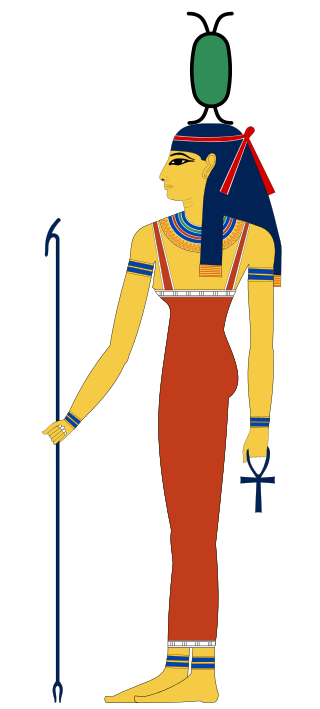
Neith was an early ancient Egyptian deity. She was said to be the first and the prime creator, who created the universe and all it contains, and that she governs how it functions. She was the goddess of the cosmos, fate, wisdom, water, rivers, mothers, childbirth, hunting, weaving, and war.
Sobek was an ancient Egyptian deity with a complex and elastic history and nature. He is associated with the Nile crocodile or the West African crocodile and is represented either in its form or as a human with a crocodile head. Sobek was also associated with pharaonic power, fertility, and military prowess, but served additionally as a protective deity with apotropaic qualities, invoked especially for protection against the dangers presented by the Nile. Sobek has been famed for having been revered by the first female Pharaoh by the Nebty name Sat-Sekhem-Nebet-Tawy Sobekneferu, present both in the female Pharaoh's nomen, Sobekneferu, and her praenomen Kasobekre.
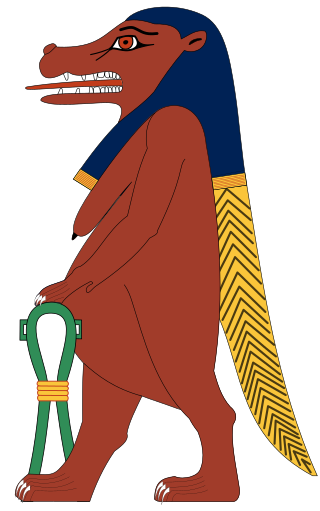
In Ancient Egyptian religion, Taweret is the protective ancient Egyptian goddess of childbirth and fertility. The name "Taweret" (Tȝ-wrt) means "she who is great" or simply "great one", a common pacificatory address to dangerous deities. The deity is typically depicted as a bipedal female hippopotamus with feline attributes, pendulous female human breasts, the limbs and paws of a lion, and the back and tail of a Nile crocodile. She commonly bears the epithets "Lady of Heaven", "Mistress of the Horizon", "She Who Removes Water", "Mistress of Pure Water", and "Lady of the Birth House".

This is an index of Egyptian mythology articles.
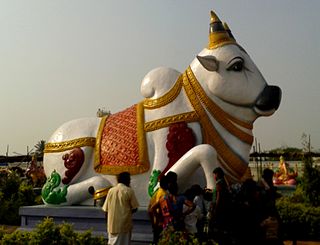
The term Animal worship is an umbrella term designating religious or ritual practices involving animals. This includes the worship of animal deities or animal sacrifice. An animal 'cult' is formed when a species is taken to represent a religious figure. Animal cults can be classified according to their formal features or by their symbolic content.

The Eye of Ra or Eye of Re is a being in ancient Egyptian mythology that functions as a feminine counterpart to the sun god Ra and a violent force that subdues his enemies. The eye is an extension of Ra's power, equated with the disk of the sun, but it often behaves as an independent goddess. This goddess can be equated with several particular deities, including Hathor, Sekhmet, Bastet, Raet-Tawy, and Mut. The eye goddess acts as mother, sibling, consort, and daughter of the sun god. She is his partner in the creative cycle in which he begets the renewed form of himself that is born at dawn. The eye's violent aspect defends Ra against the agents of disorder that threaten his rule. This dangerous aspect of the eye goddess is often represented by a lioness or by the uraeus, or cobra, a symbol of protection and royal authority. The Eye of Ra is similar to the Eye of Horus, which belongs to a different god, Horus, but represents many of the same concepts. The disastrous effects when the eye goddess rampages out of control and the efforts of the gods to return her to a benign state are a prominent motif in Egyptian mythology.
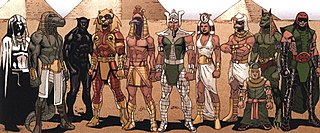
Heliopolitans are a fictional group of gods, based on Ancient Egyptian deities, appearing in American comic books published by Marvel Comics.
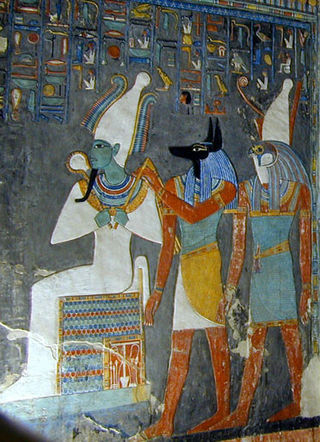
Ancient Egyptian deities are the gods and goddesses worshipped in ancient Egypt. The beliefs and rituals surrounding these gods formed the core of ancient Egyptian religion, which emerged sometime in prehistory. Deities represented natural forces and phenomena, and the Egyptians supported and appeased them through offerings and rituals so that these forces would continue to function according to maat, or divine order. After the founding of the Egyptian state around 3100 BC, the authority to perform these tasks was controlled by the pharaoh, who claimed to be the gods' representative and managed the temples where the rituals were carried out.
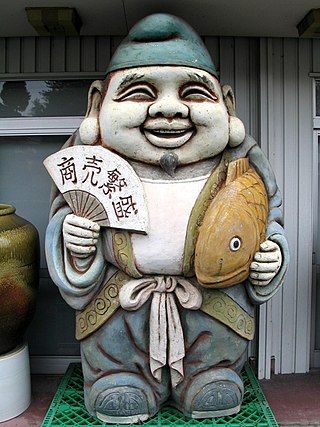
Shinto is frequently a theme in Japanese popular culture, including film, manga, anime, and video games. Shinto religion is at the core of Japanese culture and history and as such greatly affects the outcome of pop culture in modern Japan.
The Kane Chronicles is a trilogy of adventure and Egyptian mythological fiction books written by American author Rick Riordan. The series is set in the same universe as Riordan's other franchises, Camp Half-Blood Chronicles and Magnus Chase and the Gods of Asgard.

The Red Pyramid is a 2010 fantasy-adventure novel based on Egyptian mythology written by Rick Riordan. It is the first novel in The Kane Chronicles series. The novel was first published in the United States on May 4, 2010, by Hyperion Books for Children, an imprint of Disney Publishing Worldwide. It has been published in hardcover, audiobook, ebook, and large-print editions, and has been translated into 19 languages from its original English.

The Throne of Fire is a 2011 fantasy adventure novel written by American author Rick Riordan. It is the second novel in The Kane Chronicles series, which tells of the adventures of modern-day fourteen-year-old Carter Kane and his twelve-year-old sister - Sadie Kane, as they discover that they are descended from the ancient Egyptian pharaohs Narmer and Ramesses the Great. It was released on May 3, 2011. The book takes place roughly three months after the first book, The Red Pyramid. It is followed by the third and final book in the series, The Serpent's Shadow, which was released on May 1, 2012.
Carter Kane is a fictional character and one of the main characters in The Kane Chronicles series, along with his younger sister, Sadie. In the novels, he follows the "path of Horus" by hosting the god. He is one of the strongest magicians in the world, next to his uncle Amos and his sister. He is in a relationship with Zia Rashid.
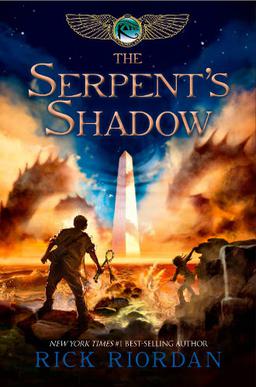
The Serpent's Shadow is a 2012 fantasy adventure novel based on Egyptian mythology written by American author Rick Riordan. It is the third and final novel in The Kane Chronicles series. It was published by Disney Hyperion on May 1, 2012.
Smite is a 2014 free-to-play, third-person multiplayer online battle arena (MOBA) video game developed and published by Hi-Rez Studios for Microsoft Windows, Xbox One, PlayStation 4, and Nintendo Switch, and Amazon Luna. In Smite, players control a god, goddess or other mythological figure and take part in team-based combat, using their abilities and tactics against other player-controlled gods and non-player-controlled minions.

Oh, Suddenly Egyptian God is a Japanese original net animation (ONA) series produced by Japanese studio Typhoon Graphics. This anime is based on Egyptian mythology and the original character design drawn by yuka. Because of the cute character designs, yuka's illustrations became popular on SNS in Japan. yuka also wrote a picture book about this and it was published by Frontier Works. The first season started airing on December 7, 2020, up to February 8, 2021. The second season premiered January 11, 2023 on Tokyo MX.















